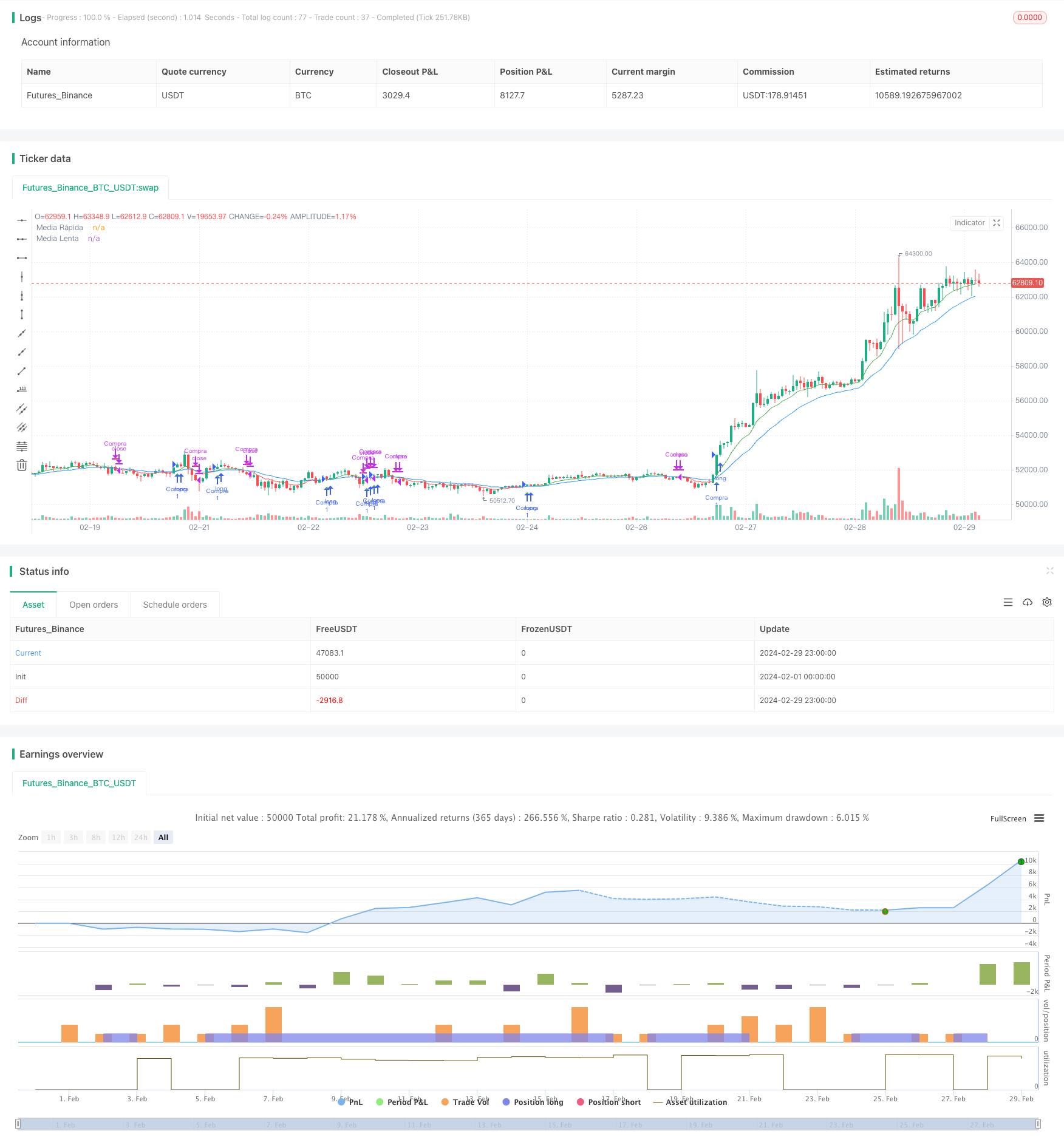
概述
该策略结合了趋势交易和移动平均线交叉的概念,利用两条不同周期的指数移动平均线(EMA)来判断市场趋势。当快速EMA上穿慢速EMA时产生买入信号,反之则产生卖出信号。此外,该策略还加入了箭头指示器和警报功能,方便交易者实时掌握交易机会。
策略原理
该策略的核心是利用两条不同周期的EMA来判断市场趋势。EMA对价格变化的反应比简单移动平均线(SMA)更灵敏,能更及时地反映市场趋势的变化。当快速EMA上穿慢速EMA时,表明上升趋势形成,产生买入信号;反之则表明下降趋势形成,产生卖出信号。同时,画出箭头指示器,直观显示买卖信号,设置警报条件,提醒交易者及时操作。
策略优势
趋势跟踪:利用EMA快慢线的交叉,能够有效捕捉市场趋势,顺势而为。
灵敏性高:相比SMA,EMA对价格变化的反应更加灵敏,能更及时反映趋势变化。
直观明了:箭头指示器和警报功能的加入,使交易信号更加直观,方便交易者实时把握交易机会。
参数灵活:快慢线的周期可以根据市场特点和交易者偏好进行调整,具有一定的灵活性。
策略风险
频繁交易:若市场波动较大,快慢线交叉频繁,可能导致过多的交易信号,增加交易成本。
延迟风险:EMA虽然相对灵敏,但仍存在一定的延迟性,可能错过最佳入场时机。
震荡市中失效:在震荡市场中,趋势不明显,EMA快慢线交叉可能会产生错误信号。
参数优化难度:快慢线周期的选择需要根据市场特点不断调整,优化难度较大。
策略优化方向
加入趋势确认指标:如ADX等趋势确认指标,辅助判断趋势强度,过滤震荡市中的错误信号。
结合其他技术指标:如RSI、MACD等,提供更多的决策依据,提高信号准确性。
优化参数选择:根据不同市场和周期,对快慢线周期进行优化,提高趋势捕捉能力。
加入止损止盈:设置合理的止损止盈位,控制单笔交易风险,提高策略稳定性。
总结
该策略通过EMA快慢线交叉来判断趋势,具有趋势跟踪、灵敏、直观等优势,但同时也面临频繁交易、延迟、震荡市失效等风险。未来可以通过加入其他技术指标、优化参数选择、设置止损止盈等方式来改进策略,提高其稳定性和盈利能力。
/*backtest
start: 2024-02-01 00:00:00
end: 2024-02-29 23:59:59
period: 1h
basePeriod: 15m
exchanges: [{"eid":"Futures_Binance","currency":"BTC_USDT"}]
*/
//@version=5
strategy("Trend Trader by Marcus Flechas y Alertas", overlay=true)
// Parámetros de las medias móviles
longitudRapida = input(9, "Longitud Media Rápida")
longitudLenta = input(21, "Longitud Media Lenta")
// Cálculo de las medias móviles
mediaRapida = ta.ema(close, longitudRapida)
mediaLenta = ta.ema(close, longitudLenta)
// Condición de compra (cruce al alza)
comprar = ta.crossover(mediaRapida, mediaLenta)
// Condición de venta (cruce a la baja)
vender = ta.crossunder(mediaRapida, mediaLenta)
// Dibujando las flechas para las señales
plotshape(comprar, title="Compra", location=location.belowbar, color=color.green, style=shape.triangleup, size=size.small)
plotshape(vender, title="Venta", location=location.abovebar, color=color.red, style=shape.triangledown, size=size.small)
// Colores del Trend Trader Indicator (opcional)
colorTendencia = mediaRapida > mediaLenta ? color.green : color.red
plot(mediaRapida, color=colorTendencia, title="Media Rápida")
plot(mediaLenta, color=color.blue, title="Media Lenta")
// Implementando la estrategia
strategy.entry("Compra", strategy.long, when=comprar)
strategy.close("Compra", when=vender)
// Condiciones de alerta
alertcondition(comprar, title="Alerta de Compra", message="Señal de Compra activada")
alertcondition(vender, title="Alerta de Venta", message="Señal de Venta activada")